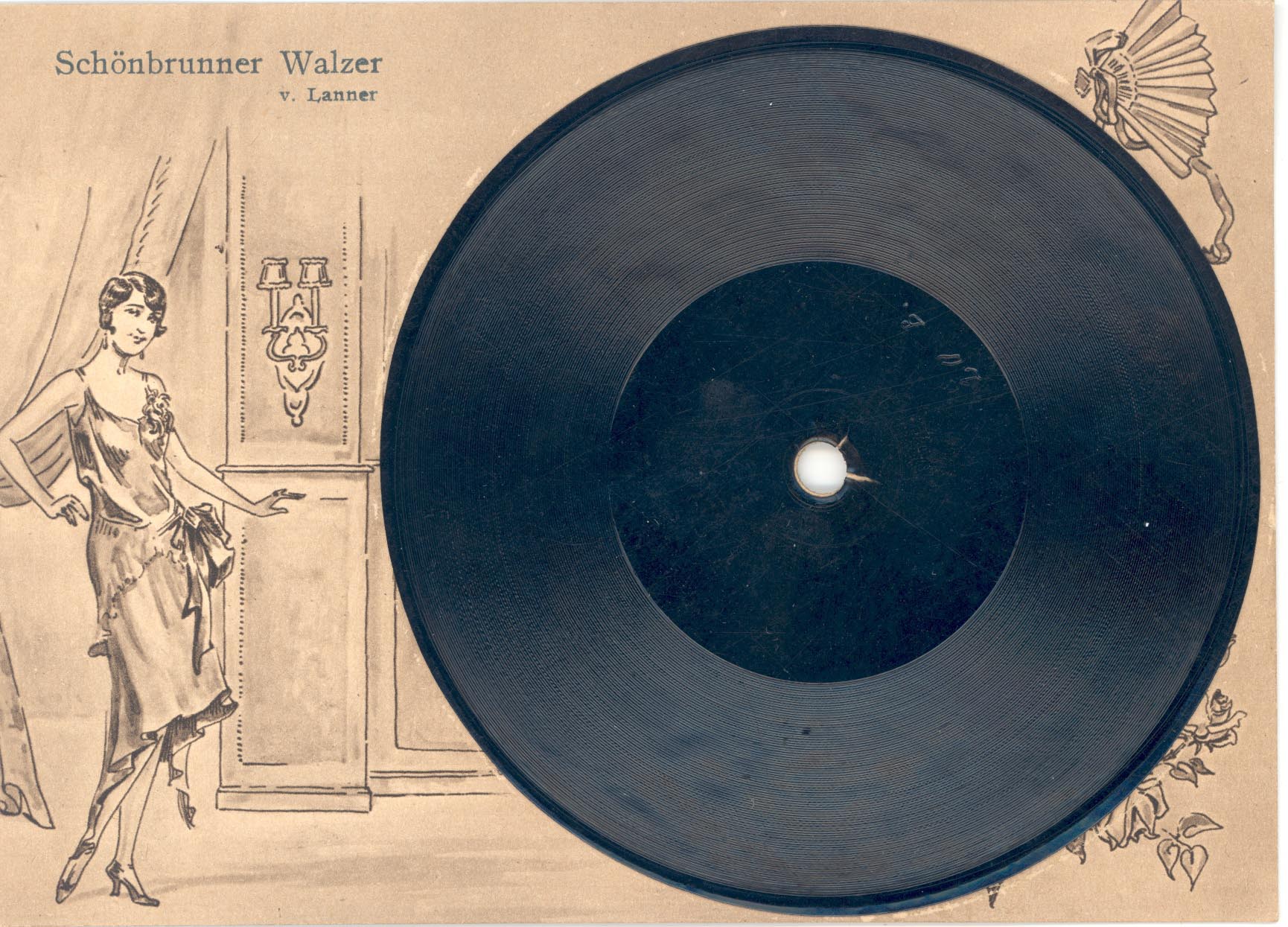 |
Phonocards & PhonopostHistory
|
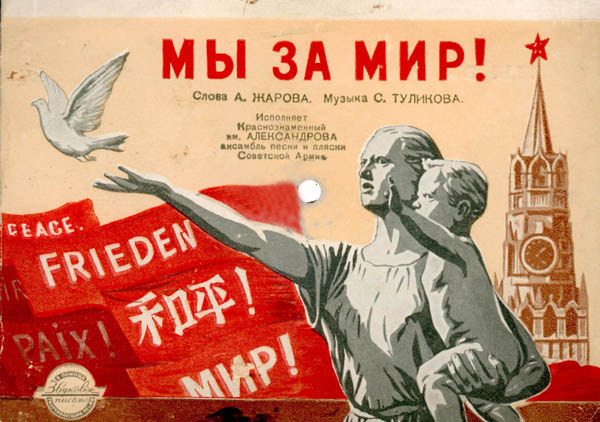 |
Acknowledgements:
Frank Andrews, Peter
Bastiné,
Arthur Badrock, Lyle Boehland
(who
provided some images), Henri Chamoux, Paul Cleary, Bill Dean-Myatt,
Alan
Dein, Matthew Dodd, Norman Fields, John Goslin, Michail Grinchuk (Russia), Herbert Gruy, Scott Hambidge (who
provided details on the Advertising Record Corporation), Benno
Häupl, Jos Hocks (who
shared his
extensive
research on the subject), Alan Kelly, Allen Koenigsberg, Hans Koert,
Raoul Konetzni, Franz Lechleitner, Joan
Lehman, Adam Miller, Kurt Nauck, Stephan Puille, Hermann Sachse (Dresden), Gary Scott, Mary
Seelhorst,
Géza Gábor Simon, Paul Sonntag, Paul Steier (New York), Allan Sutton, Steve
Walker,
J. D. Weeks, Christian Zwarg.
Introductory notes:
To the best of my knowledge, this is the first attempt to shed some
light
on the 78rpm “talking postcard”, which was known under many names in
many
countries, including: Fonopost, Sprechende Postkarte, Musik-Postkarte,
Schallplatten-Postkarte, Tonbild-Postkarte, Talking Card, Gramophone
Record Postcard, Phonogram Card,
Singing Postcard, Carte Postale Parlante, Phonopost, Phono-Postal, Carte-Disque,
and
variations thereof. Although the invention dates back to 1903,
collectors of shellac discs looked down on this artifact, presumably
because none of
the “big names” are captured on them. Likewise, collectors of
phonographs or gramophones neglected the talking postcards, because
they are difficult tor reproduce and tend to have a faint sound.
Nevertheless, they are a fascinating
subject not only for technical reasons but also because of their
obvious
social implications which latter aspect was in the foreground of a BBC
radio feature in 2002 [Matthew Dodd & Alan Dein, "The Singing
Postcard", London, 18.08.2002].
A two-part history of the early phono postcards was published in German
language as "Phono-Karten, eine industriegeschichtliche
Entdeckungsreise"
1. Teil: Der
Schalltrichter, Jg.18, Nr.27, Mai 2006
2.Teil: Der
Schalltrichter, Jg.18, Nr.28, November 2006
The basic idea of a gramophone postcard is to glue a single sided miniature disc record onto a postcard and punch a center hole through both card and disc. Since the normal shellac compound used in the manufacture of disc records would be too heavy and breakable, the disc records could be made of plastic material or celluloid. The material could be black, a brownish opaque or colorless translucent.The first presently known reference to a gramophone postcard is an advertisement in the 17 November 1903 issue of the German language Phonographische Zeitschrift, when Zonophon G.m.b.H. at Berlin announced they would distribute an "epochal" invention described as "Die sprechende, singende und musizierende Ansichts-Postkarte". A year later, in October 1904, patents were claimed both in Germany and in France. Emilien-Jean-Baptiste Brocherioux, the dealer Paul-Joseph Tochon and the printing company of Société Fortier et Marotte in Paris, France, jointly registered trademarks including Tebehem, La Phonopostale, Phonopostal, La Phonocarte, Cartophone, Sonorine, Postphonocarte etc. for phonographs capable to record sound on "feuilles, cartes, cartes-lettres et cartes-postales". It is uncertain whether all these names have been used for the manufacture of actual gramophone postcards. Examples of Tebehem have been found, and in December 1905 the German press reported that a talking postcard was recently introduced in Paris from the US: "Die sprechende Postkarte, der man den Namen Sonorine gegeben hat, wird vor allem dazu dienen, das Briefgeheimnis zu wahren, was bisher nicht möglich war. Natürlich kann auf diese neue Art und Weise nur zwischen Personen korrespondiert werden, die sich im Besitze der dazu nötigen Apparate befinden. Die Pariser Postverwaltung hat daher nach Art unseres Telephon-Adressbuches ein Verzeichnis der Bewohner von Paris herausgegeben, die Phonographen für die sprechende Postkarte ihr eigen nennen" [Speyerer Zeitung, 02.12.1905]. Thanks to researcher Jos Hocks some of the patents can be uploaded here. The invention was interesting enough to be featured on a chromolithograph issued by - presumably - the Liebig company:
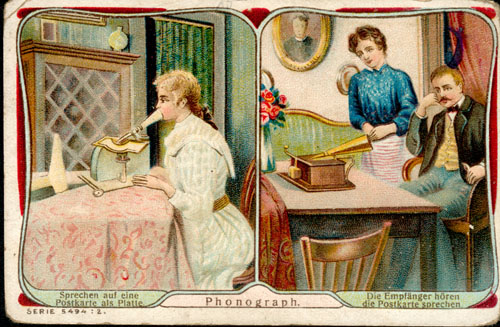
On October 7th 1904 Max Thomas, manufacturer of phonographic machinery and requisites at Berlin, claimed a patent for Phonogram Cards, for which he also applied in the United Kingdom in August 1905: "It has been proposed to enable persons, each provided with a gramophone, to converse one with the other by sending through the post a postcard or lettercard composed of paper or celluloid which has been previously impressed by the recording device of the sender's instrument ... Such cards, however, when made of ordinary paper, have not been found very suitable for this purpose, whilst cards made entirely of celluloid lack stiffness and are expensive ... For the purposes of my invention I prefer to employ disc records of thin transparent celluloid, first, because the small weight of this material does notcause any appreciable increase in the cost of postage, and second, because such records can be mounted over a picture or other representation without obscuring the same" [text page 1, text page 2, drawing page 3]. The March 17, 1905 issue of the Daily Mirror had an article about the German inventor Max Thomas marketing some 80 (!) singing postcards in Great Britain. By 1905 phonocards were sold in Germany by Zonophon and Jacob Katz, and also in England. In 1906 Paul Schönecker of Berlin entered a trademark for gramophone postcards. In 1910 in Germany, Zonophon announced what they called "Musik-Postkarten" (songs, marches, or congratulations recorded to order) and claimed the total playing time to be 1/3 of a regular disc. The material could be black, a brownish opaque or colorless translucent.
In the US the opaque surface of the record was patented in 1907. Since US rules allow patenting without commerce the actual manufacture may have started as late as 1915 when the Federal Novelty Imprinting Co. of New York City produced cards that had a miniature phonograph record attached to them that played a brief greeting. The August 1915 issue of an unidentified American journal carried the following: “Novel Post-Card Records for Phonograph: Post cards on which miniature disk-phonograph records are pasted are novelties which are becoming more or less popular in certain parts. The cards employed are of standard size, while the records, which are secured in the middle, occupy about one-half of the space on the side to which they are attached. They are not dissimilar to many of the sample records which from time to time have been used for advertising purposes, excepting that they are slightly smaller in size. While they are not of indefinite life, the records give surprising results the first time or two they are used.”
Unfortunately most of the pre-WWI German, French, British and American gramophone postcards bear no information indicating the date or manufacturer. The autopsy of postally run cards sometimes provides clues through cancellation stamps or handwritten information. Some gramophone cards have the disc attached to a beautiful embossed floral or pictorial design - like "Kind, du kannst tanzen". This type of card was manufactured by Zonophon at Berlin from 1910. Another popular type of card had apparently been manufactured in Germany by Musika for export to the United States, a striking example being a card which combines a recording of a "Cake Walk" with a matching image of black dancers and musicians. The titles of the tunes are written into the discs in beautiful handwriting, clearly indicating that both "Cakewalk" and "Kind du kannst tanzen" are made by the same company: Zonophon. In fact, most - if not all - Zonophon cards were also released by Musika, although the corporate link between Zonophon and Musika is unclear. Musika may also have been owned by Grammophon.
In 1908 Épis de blé was registered as a trademark in France for the Carte Postale Parlante. In the same year Louis Boduin registered Ebonitine. In 1910 in Germany, Zonophon announced what they called "Musik-Postkarten" (songs, marches, or congratulations recorded to order) and claimed the total playing time to be 1/3 of a regular disc.
Prior to WWI the French Pathé company marketed small discs for self-recording purposes, manufactured of a blackish plastic or lacquer (”Sonorine”), often mounted on a rectangular carrier. The discs and the corresponding play-back machine were called “Phono-Postal”. The rectangular (!) „turntable“ was a sort of picture-frame in which the cards were clamped. The Phono-Postal was thus strictly speaking not a pre-recorded postcard, but a self-recorded disc. At any rate it could not be played on a regular turntable as it was lateral cut.For the purpose of self-recording Pathé also marketed double sided discs, which had a diameter of 10cm, that would be put into a special Pathéposte envelope for mailing.
Probably the first company in France to
manufacture real phono cards on
a commercial scale was E.P.I. In December 1908 E.P.I. (Épis
de
blé) was registered as a trademark in Paris for the Compagnie
Générale
d' Electricité. However, already in July 1908 Louis Boduin
registered Ebonitine
for
the strange purpose of "être apposée sur des boites ou
récipients
quelconques contenant un produit destiné à lubrifier les
disques
des machines parlantes". The illustration that goes with the
application
depicts a disc record "Ebonitine", the slogan "to be used for needle
cut
and sapphire cut discs" as well as the inventor's initials - LB. It is
not
presently known whether Monsieur Louis Boduin, of 7 Galerie du
Commerce,
at Amiens, ever produced this device, nor whether he manufactured any
disc
records. But about 20 years later the initials "LB" turn up again on gramophone postcards, at
about
the same time when Raphael Tuck produced his cards in England.
Leon Leibowich & Co, in October
1909, began advertising a novelty in 3 1/4 diameter records on
postcards or playing cards.The cards played band and other recordings:
"Surprise your friends owning needle disc machines with these musical
greetings" ran the advertisement emanating from 131 Wardour Street,
London. In December 1909 a trade paper, "The Sound Wave",
reviewed Leibowich's post cards, saying they had considerable volume
and a good tone. Leibowich advertised the recordings as marches,
waltzes, etc. These were affixed onto magnificent relief picture post
cards of various shades and designs.
Little is presently known about the
situtation in the US. The striking Stag Tobacco
advertising cards refer to patents dating from 1901, 1902, 1906, 1908
and 1909, and it
can be assumed they predate the US entry in WWI. Some cards, clearly
intended
for export to the US, have been manufactured in Germany. Among these
are
cards with the trade-mark “Musika”.
Nothing is known about this company, which may or may not have been
associated with “Musica”, a name that was protected by French singer
and entrepreneur George Dutreih in Paris in 1904, and renewed by the
German Polyphon Werke Aktiengesellschaft in 1921. It seems that ,
unlike the situation in Europe, most “Talking Cards” in the US were for
advertising purposes. The more important
among these were the Greetaphone Co at Kansas City, the Record Voice
Co.
Laboratories at Canton, O. and the A[dvertising] Record
Corp. at
New
York City (around 1923), which later became the Record Corporation at
Cliffside,
New Jersey. The latter had an arrangement with the Pathé film
company
– at least one card is known to feature a selection from the Edgar
Wallace
thriller “The Green Archer”. Another card bears a message from Arthur
Whitney,
Republican Candidate for Governor. (The
election was for the New Jersey Governor in 1925, in which he was defeated). On
many
American cards the records are attached by two staples close by the
center
hole, a procedure not in use in Europe.
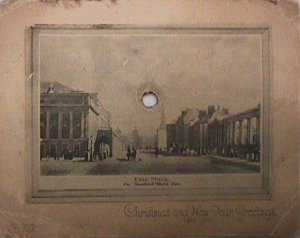 ...
... ...
...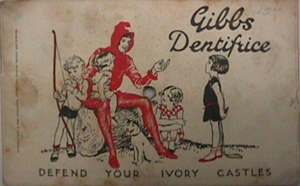 ...
...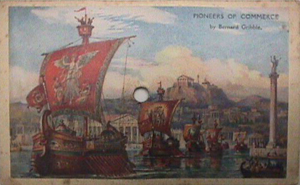
Judging by the numbers of cards still
turning up at flea markets, the only
company that succeeded in manfacturing Gramophone Record Postcards
commercially
in large amounts seems to have been Raphael Tuck. The
Raphael
Tuck Company published their first Christmas greeting card in 1871, and
the
first picture postcard in 1894. The Tuck Company entered the American
postcard
market in 1900 and maintained an office in New York. American artists
designed
the postcards and they were printed in Germany and England and returned
to
the U.S. for sale. In 1929 Tuck went into the business of producing
Gramophone
Record Postcards. As all kinds of postcard designs (landscape view,
greeting
cards, art reproductions) turn up, and the pictures are largely
obscured
by the dark-brown opaque recording material, it is thus probably safe
to
assume that Tuck used obsolete old postcard stock as raw material for
their
product. The cards do look much older than 1929, and the designs hardly
ever
have any logical relation to the (electrically) recorded sound pasted
upon
them. Any recording could be pasted on any postcard – and,
discographically
speaking, noting details of the postcard designs would be irrelevant.
The
musical selections are exclusively public domain, no money was spent on
music
rights and royalties.
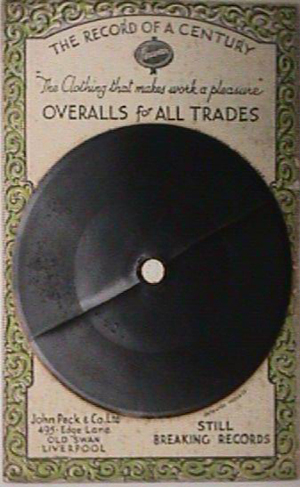 ...
...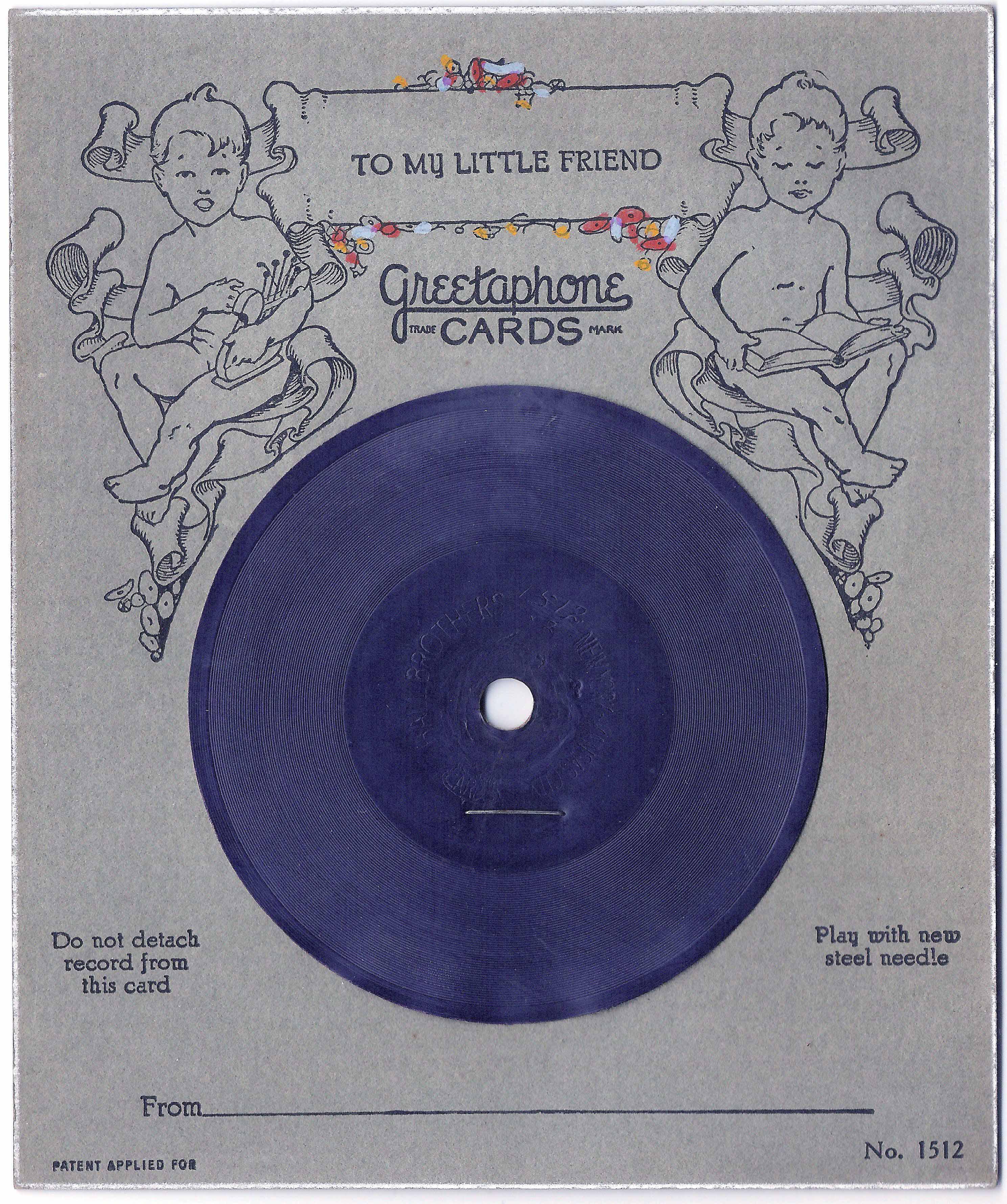 ...
... 
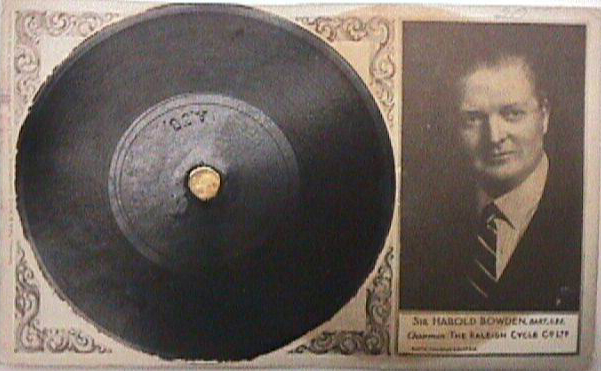
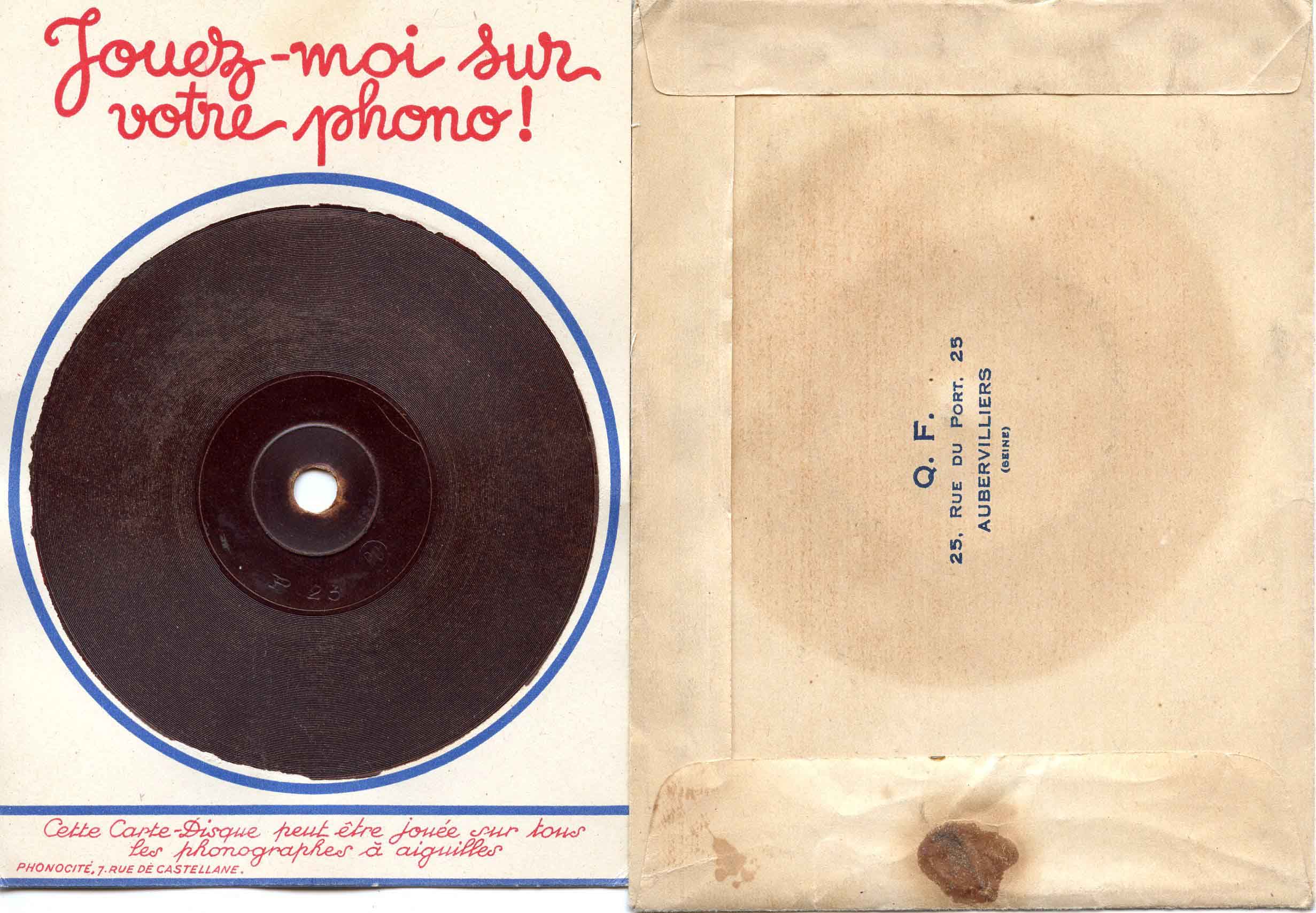
Singola at Berlin, Germany produced opaque, brown discs which could be
glued
upon postcards for advertising purposes. A good number of such custom
made
cards can be dated to 1931. As well, the publishing house F. Marxen at Mainz
entered
into a special contract with Singola and marketed a series of some five
“Schallplatten-Postkarten”
featuring Rhine- and drinking songs for the Rhineland tourist trade. It
was probably Singola who
produced a series of otherwise unidentified phono-postcards.
In striking contrast the Weco company in Germany, which also started in 1929, mostly used excellent photographs, entirely coated with a translucent material into which the grooves of the electric recordings were pressed. Musical content and graphic designs often matched, and renowned artists were employed to record recent compositions. Weco also produced advertising cards. Although the Weco phono cards seem to have been quite popular in Germany, Austria, Czechoslovakia, France, The Netherlands, Spain and probably other countries – at least 230 cards were produced in quick succession – the economic depression wiped this high quality product off the market within less than three years.
There were also short-lived revivals of Cartes-Disque in France, e.g. those produced by Phonocité (copyrighted by Georges Binoche, Paris, in May 1930). In all probability they were publicity handouts by the Chatelet operetta theatre, as they featured excerpts from André Baugé’s commercial Pathé recordings. Other cards were “Quick - Carte Postale Disque” (for popular chansons), or “Phoncarte Birum” produced by Birum Invar at Paris.
From now on, for more than 20 years,
phono postcards playing at 78rpm have
not been produced in large scale until the Soviet Union revived the
invention
in 1950, when the "Design
and art workshops of the Art Department of the Moscow City Executive
Committees" produced folded phono cards
[Swukowoje Pismo] which
could be opened up.
However, the recording technology would soon change from 78rpm standard
groove
to 45rpm and 33rpm microgroove: Up to the 1970s a large number of
companies
all over the world produced such microgroove. A selection of such cards
would
include: Linder Tönende Ansichtskarte (West Germany), Ninophon
(West
Germany), Orchestrola (West Germany), Schallbild (West Germany),
Supraphon
(CSSR), Vistasound Singing Picture (England). Colorvox (Hungary) was
owned
by Képzömüvészeti Alap
Kiadóvállalata, i.e. the Publishing House of the Art
Foundation Budapest; the cards were pressed
by Budapest Hanglemezgyár and by VSZM (Villamosszigetelö
és
Müanyaggyár); the company not only used Hungarian
recordings
for distribution in Hungary, but also masters recorded in East
Germany,
for distribution in the German Democratic Republic. Cards were also produced in
1960s Japan. Poland was well
known
for producing pirated versions of Western pop recordings on a variety
of
carriers including plastic as well as cardboard and what appears to be
obsolete
wallpaper stock.
Postscriptum: In 2007 the idea was
revived by the Scotdisc company at Glasgow: They market Music Video
Postcards from Scotland to which an 8cm diameter removable DVD is
attached. They are currently available and widely distributed at 1,25
GBP (£).
For further details and exploratory discographies of some brands
click the following links
E.P.I. (épis de blé)
Greetaphone
Cards
LB (Louis Boduin)
Quick
Singola
Tuck
Weco
Zonophon/Musika
Last updated 2025-07-03
If you have additions or corrections: Please contact us by e-mail:
Rainer
E. Lotz
Rainer E. Lotz
Rotdornweg 81
53177 Bonn, Germany
Phone(International): +49-228-352808 / Phone(National): 0228-352808
Fax (International): +49-228-365142 /
Fax (National): 0228-365142
Rainer
E. Lotz







